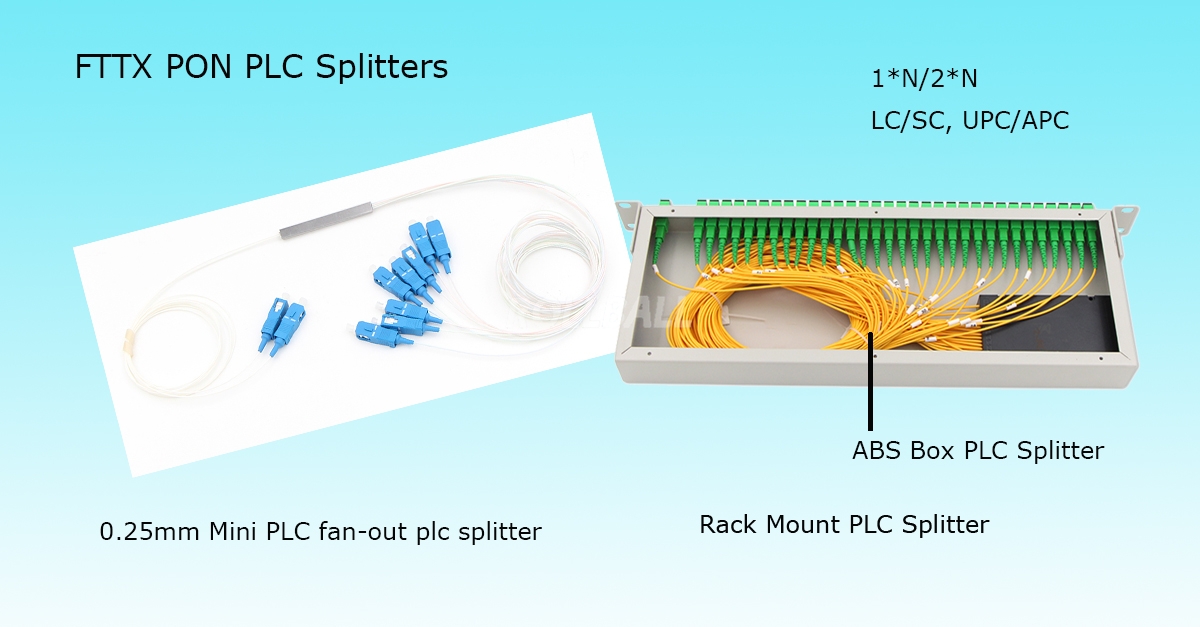By szrollball | 05 July 2017 | 0 Comments
What are the types of optical splitter? How to choose the right optical splitter

Optical splitter, also known as the splitter, it has a number of input and output, optical fiber link is one of the important passive devices, in the accelerated light into the copper back, push access network strategy to play Play an important role. According to the principle of spectroscopy, optical splitter can be divided into melting tapered and planar waveguide type (PLC).
Melting tapered optical splitter
Theoretically, the frequency band of fiber up to 30 billion megahertz. Although the optical fiber has different losses on the light of different frequencies, the bandwidth in the lowest loss area can reach 30000GHz. The use of advanced coherent optical communication can be achieved in the 30000GHz range of 2000 optical carriers, wavelength division multiplexing, can accommodate millions of channels. At the same time, fiber transmission speed, can provide 10Mbps, 100Mbps, 1000Mbps high-speed bandwidth, to achieve two-way data synchronization transmission.
Advantages of Melted Tapered Optical Splitter
Melting tapered optical splitter technology is mature, has a long history, compared with the plane waveguide optical splitter, it has the following advantages: 1. Easy to obtain raw materials. Fused tapered optical splitter of the raw materials are quartz substrate, heat shrink tubing, stainless steel pipe, fiber, etc., easy to obtain, equipment and machine investment depreciation fee is also very small. Low cost Fused taper-type optical splitter has more than 20 years of history and experience, the development cost is only a few or even a few hundred percent of the PLC. 3. Can be made unequal splitter. Real-time monitoring, according to the need to produce unequal splitters.
The drawbacks of the melted tapered optical splitter
At the same time, the melting tapered optical splitter also has the following shortcomings: 1. Uniformity is poor: can not ensure uniform spectroscopy, 1X4 nominal difference of about 1.5dB, 1x8 or more difference, to a certain extent, will affect the overall Transmission distance. 2. Loss with temperature changes, easy to damage. This kind of production process is due to the inconsistency between the thermal expansion coefficient of the solidified rubber and the quartz substrate and the stainless steel pipe, and the degree of thermal expansion and contraction when the ambient temperature changes is inconsistent. This situation is easy to cause the optical splitter to be damaged. 3. Large size. Multi-demultiplexer (1x16, 1 x32) the volume is relatively large, the installation space will be subject to certain restrictions, the relative reduction in reliability.
Planar waveguide type optical splitter (PLC)
Plane waveguide optical splitter, also known as PLC optical splitter, the use of lithography and semiconductor technology production, shunt function focused on the chip, you can achieve a chip up to 1X32 above the shunt, and finally in the The chip ends are coupled to the input and input terminals for encapsulation.
Advantages of Plane Waveguide Splitter
Compared with the melt-pull-type optical splitter, the advantages of planar waveguide type splitter: 1. Spectral uniformity, the signal can be evenly distributed to the user 2. Compact, small size, can be installed directly in the existing Kind of transfer box, do not leave a lot of installation space. 3. Loss is not sensitive to the transmission wavelength, to meet the needs of different wavelength transmission. 4. The lower the cost of the road, the lower the number of branches, the more obvious the cost advantage. 5. Single device shunt channel, up to 32 or more.
Disadvantages of Planar Waveguide Splitter
The following disadvantages are also found in the plane waveguide splitter compared to the melt-pull-type optical splitter: 1. The cost of the split-splitter is higher and the low-channel splitter is at a disadvantage. 2. The production process is complex, the technical threshold is high, the chip is dominated by several foreign companies, domestic manufacturers less.
How to choose the right optical splitter?
Before selecting the optical splitter, determine the user's needs and use. In some small shots, volume and light wavelength is not very sensitive occasions, the use of pull-type optical splitter low cost, more affordable, such as TV video network can choose 1550nm pull cone splitter; independent data transmission selection 1310nm pull cone-type splitter; and in the FTTH, triple play, such as multiple wavelengths of light transmission and the user more occasions, should use the plane waveguide splitter. As the core of FTTH optical devices, optical splitter is widely used in FTTB (fiber to building), FTTH (fiber to home), FTTD (fiber to desktop) and triple play. Rollball offers a variety of FBT splitters and PLC optical splitter, can also be customized to meet your different needs.
Leave a Reply
Your email address will not be published.Required fields are marked. *
POPULAR BLOG